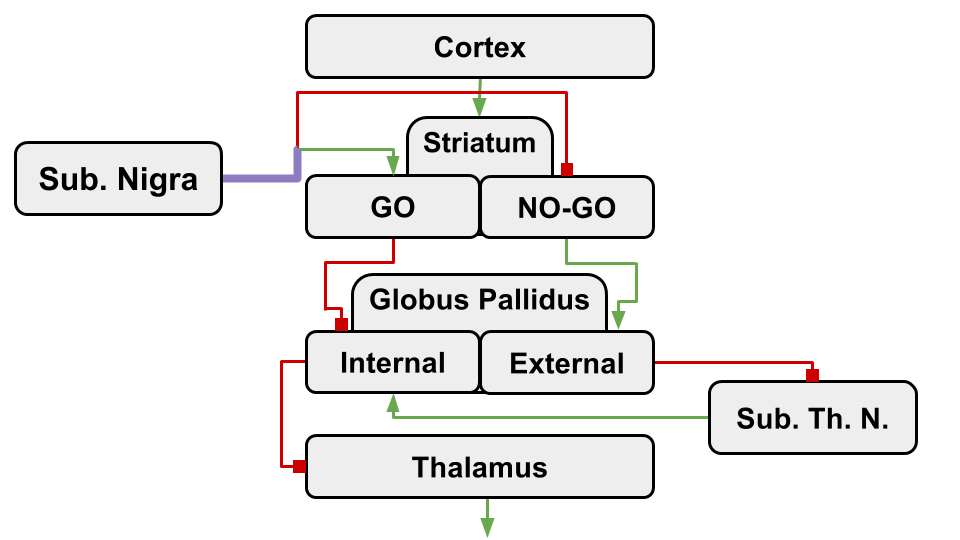Answer
The basal ganglia include the dorsal and ventral striata, the substantia nigra, the globus pallidus, the ventral pallidum, and the subthalamic nucleus.
The critical circuit for motor command generation is diagrammed below. Dopaminergic input is in purple, with sign-preserving synapses represented by green arrows and sign-inverting ("inhibitory") synapses represented by red blocks. As is tradition.

Motor commands are generated in the cortex. Such commands are created spontaneously and promiscuously in response to sensory input. An important function of the basal ganglia is to select which of these commands to execute, integrating reward and error prediction signals based on dopaminergic signaling.
These commands enter the basal ganglia at the striatum. Two distinct sub-populations of inhibitory neurons receive the signals. Though they are morphologically indistinguishable (they both have a medium size and spiny appearance), these two populations express distinct receptors for dopamine. One group, which expresses D1-type receptors, is in the "GO" or the "direct" pathway, while the other, which expresses D2-type receptors, is part of the "NO-GO" or "indirect" pathway.
Dopamine is sent to this circuit from the substantia nigra, or "black substance". This color is not a coincidence: the pathway that generates dopamine can also lead to melanin, the pigment molecule that gives skin its color.
The result of a dopamine release by the SN is movement, no matter which sub-population within the striatum is targeted.
The direct pathway takes two steps to reach the thalamus from the striatum, and both are inhibitory. Two inhibitory synapses have the same effect as an excitatory synapse:
(--) -> (+)
so exciting the direct pathway excites the thalamus, which generates motor output. See the bottom of the page for more on this little toy syntax. When we write the full circuit out, we get:
(+--) -> (++) -> (+)
The indirect or no-go pathway has some extra steps. Without the substantia nigra, the indirect pathway contains three inhibitory synapses: striatum-globus pallidus external, GPE-subthalamic nucleus, and GP internal-thalamus. When we include the excitatory synapse from the STN to the GPI, the result is
(--+-) -> (++-) -> (+-) -> (-)
So the indirect pathway inhibits movement.
The SN, however, inhibits the indirect pathway, so we have:
(--) -> (+)
and so dopaminergic input to the indirect pathway promotes movement.
A Simple Circuit Syntax
We can figure out the result of a circuit by playing a little game. We write the steps of the circuit out in a string like so:
(+---+++--+ ... )
So long as the circuit is feedforward, it can be arbitrarily long. We use two simple rules to shorten this string and figure out what the output of the whole circuit is:
- any number of
+symbols can be shortened to just one+ - a pair of
-symbols can be converted into a+
You may recognize these as the rules multiplying positive and negative numbers,
or for adding odd and even numbers.
Armed with these rules, we can shorten any string of symbols
like the one above into just one symbol: + or -.
The mathematically-minded will notice the connection (isomorphism) to the
bit-parity operation,
which would operate on the string encoding our symbols with 1 and 0,
or to the
cyclic group Z2.
In either case, we realize that all we are doing is figuring out whether we have an odd or an even number of inhibitory steps, and our job is made slightly easier.